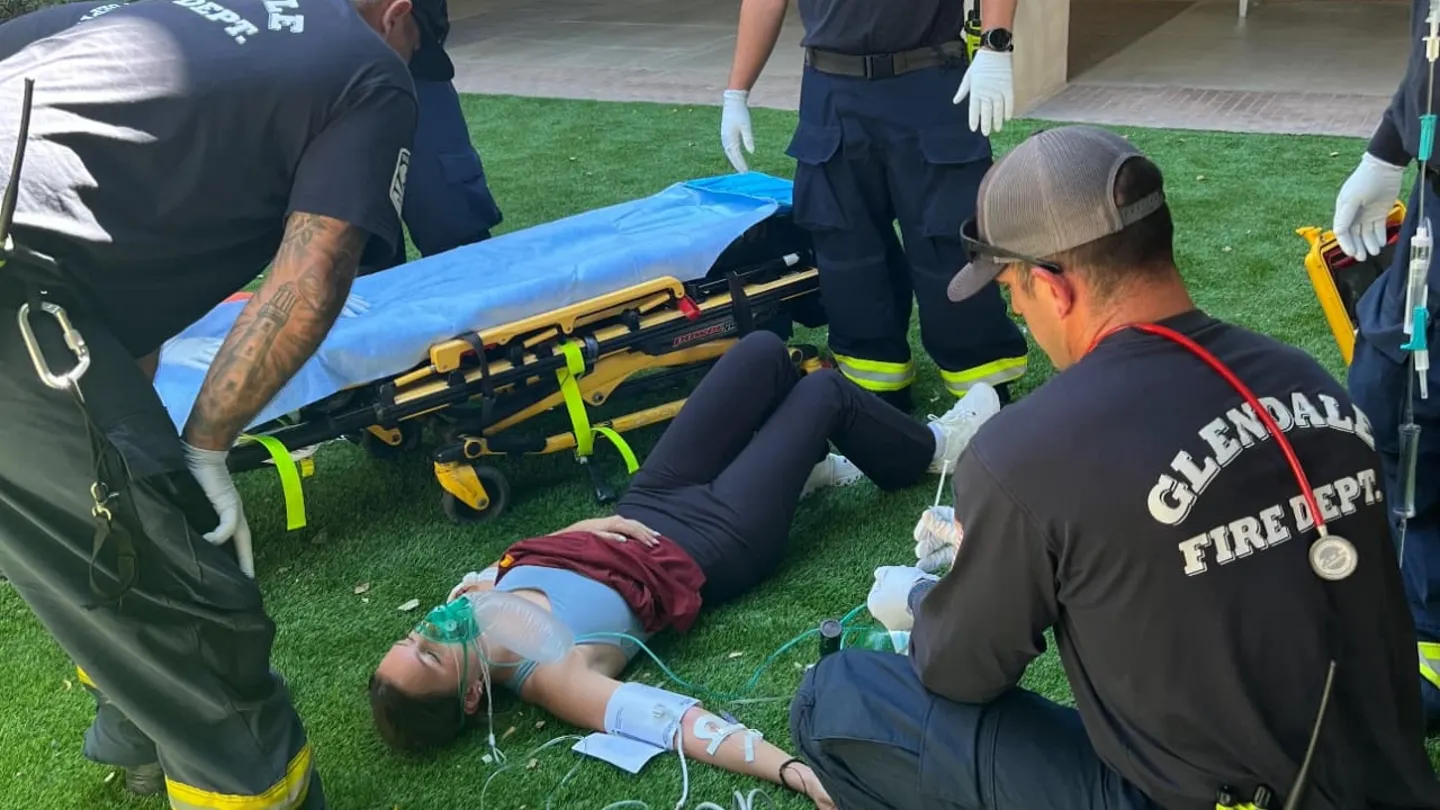Preparedness
Heroic Student Saves Classmate in Shocking Arizona Campus Attack

An Arizona State University student was the victim of a seemingly random and violent attack in a classroom in Glendale on September 19. The incident has left the campus community in shock and rallying around the victim, Mara Daffron.
Kaci Lenise-Charlie Sloan, 19, has been charged with first-degree attempted murder, aggravated assault with a deadly weapon, and disorderly conduct with a weapon. According to Maricopa County authorities, Sloan allegedly stabbed Daffron twice in an unprovoked assault.
Daffron’s neighbors have come together to support her through a GoFundMe campaign, stating she was “stabbed several times, but luckily, she is making great progress and is on the mend.”
“We’d like our community to come together and support the Daffron family during this difficult time,” reads the GoFundMe page titled “Support Mara Daffron’s Recovery Journey.”
“We know Mara will come out stronger than ever from this unimaginable attack.”
Matthew McCormick, a fellow student who witnessed the attack, intervened and potentially saved Daffron’s life.
“As she was going for a third attack, I was able to grab her wrists and apprehend her before further damage could be done,” McCormick told FOX 10 Phoenix.
“In that moment I didn’t really have a thought going through my head I just knew that I felt compelled to do something,” he added.
Approximately 13 witnesses, including a professor, were present during the attack. According to a probable cause affidavit obtained by Fox News Digital, the stabbing occurred “without any provocation or any words spoken.”
One witness managed to disarm Sloan by pulling the knife away from her right hand and throwing it across the room. Another witness then “kicked the knife to the back of the classroom.”
“Another witness described the defendant was sitting in the classroom at a desk and suddenly got up and ran at the victim as the victim entered the classroom and stabbed her multiple times,” the affidavit states.
Detectives found a handwritten note in Sloan’s backpack that referenced an act she was “about to commit,” though it did “not specifically state what she was referring to.”
“After reading her Miranda Rights, the defendant admitted she came to class to hurt somebody and was planning the attack since the night prior.”
Sloan expressed a desire to “hurt somebody” in class that day and chose Daffron as she was “an easier target” compared to another person she considered attacking, whom she referred to as “a veteran.”
Authorities quickly arrived on the scene and transported Daffron to a nearby hospital for treatment.
An ASU spokesperson told Fox News Digital, “ASU Police continue to investigate a Sept. 19 on-campus stabbing of a student. Kaci Sloan was immediately detained and arrested on suspicion of first-degree attempted murder; aggravated assault with a deadly weapon; interfering with an educational institution; and disorderly conduct. She is being held on a $250,000 cash-only bond.”
“ASU and the entire ASU West Valley community are deeply saddened by what happened. ASU West Valley is a close-knit campus of students, faculty, and staff. Counseling support is available to all.”
Watch a local news report about the incident below:
Let us know what you think, please share your thoughts in the comments below.

Preparedness
10 Cheap Preps and Survival Tools You Can Buy for Under 10 Dollars

You do not need a huge budget to build a reliable emergency kit. Some of the most useful survival items are inexpensive, simple, and easy to find at any hardware store, dollar store, or online. For under 10 dollars, you can add tools that keep you warm, help you navigate darkness, protect your supplies, and give you an advantage when a crisis hits. Survival does not start with expensive gear. It starts with smart choices that give you options when you need them most.
Here are ten low-cost essentials that can make a real difference in any emergency.
1. LED Flashlight
A basic LED flashlight is one of the most important tools you can own. Even small models provide strong light, last a long time on batteries, and fit easily into a pocket or bag. In any power outage, losing visibility is the first major challenge. A cheap flashlight solves that instantly.
2. Waterproof Matches or a Butane Lighter
Fire is essential for warmth, light, boiling water, and morale. Waterproof matches or a simple butane lighter cost very little and work in nearly any weather. Keep several in different locations, such as your car, kitchen, and emergency kit.
3. Emergency Mylar Blanket
These thin, reflective blankets trap body heat and prevent hypothermia. They weigh almost nothing and fold down to the size of a wallet. Mylar blankets are used by hikers, first responders, and disaster teams because they work. At under a dollar each, they are one of the best survival bargains you can buy.
4. Duct Tape
Duct tape might be the most versatile tool in survival. You can patch a tarp, repair a tent, secure a bandage, create a splint, seal drafts, or waterproof containers. A small roll is cheap, portable, and useful in almost every emergency situation.
5. Plastic Tarps
A simple tarp can act as shelter, roof patching, ground cover, rainwater collection, shade, or wind protection. Even lightweight tarps create instant barriers between you and the weather. They are one of the most efficient budget tools for surviving outdoors or protecting your home.
6. Batteries
A flashlight is useless without power. Stocking AA or AAA batteries ensures your lighting, radio, or small devices continue to work during blackouts. Rotating your batteries once a year keeps them fresh and ready.
7. Water Storage Containers
Clean water is the first priority in any emergency. Inexpensive plastic jugs or collapsible water containers allow you to store several gallons safely. Keeping extra containers around means you can fill them quickly before storms or boil-water advisories.
8. Basic First-Aid Supplies
Under 10 dollars, you can build a simple first-aid kit that includes bandages, antiseptic wipes, gauze, tape, and pain relievers. Minor cuts and infections become serious problems during emergencies. A small, inexpensive kit prevents these issues from getting worse.
9. Candles or Tealights
Candles are a cheap and reliable backup source of light. They are easy to store and last a long time. A few tealights can illuminate a room and provide comfort when power is out. Just use them safely and never leave them unattended.
10. Multi-Tool or Pocket Knife
Many budget multi-tools cost under 10 dollars and still offer blades, screwdrivers, scissors, and small pliers. They are not as rugged as premium tools, but in a crisis, having even a basic multi-tool is far better than having nothing.
Final Thoughts
Building a survival kit does not require expensive gear or specialty equipment. These ten tools cost less than a takeout meal, yet each one adds real strength to your ability to handle emergencies. Start with the basics. Add a few items each month. Over time, you will build a dependable, low-cost emergency setup that prepares you for storms, outages, travel problems, and unexpected challenges.
Off The Grid
10 Foods That Could Save Your Life When Crisis Hits

When a real emergency strikes, the first thing most people lose is access to fresh food. Storms shut down roads, power outages spoil everything in the refrigerator, and grocery shelves empty faster than anyone expects. Having the right foods stored can turn a dangerous situation into something you can manage calmly. The key is choosing items that last a long time, do not require refrigeration, and can give your body the energy it needs when conditions get tough.
Here are ten simple, affordable foods that could literally keep you alive when everything else disappears.
1. Canned Beans
Canned beans are one of the most complete emergency foods on the planet. They are packed with protein, fiber, and slow-burning carbohydrates. They can be eaten cold right out of the can if there is no power. Black beans, kidney beans, chickpeas, and pinto beans all work the same way.
2. Rice
Rice is a survival classic because it lasts for years, stores easily, and gives steady energy. White rice stores longer than brown rice, but both are excellent. Combined with beans, rice becomes a complete meal that keeps you full and focused during tough situations.
3. Peanut Butter
Peanut butter is calorie-dense, shelf-stable, and requires zero preparation. A single spoonful provides fat, protein, and fast energy. It can stay good for months after opening if stored in a cool place. In any emergency, peanut butter becomes a go-to survival powerhouse.
4. Canned Meat
Tuna, chicken, salmon, and Spam all offer long-lasting protein that does not require cooking. Canned meat keeps hunger away and helps your body stay strong when facing stress. Always keep a few cans in your emergency kit or pantry.
5. Oats
Oats are cheap, filling, and versatile. You can eat them hot if you can boil water or cold by soaking them for a few minutes. They give long-lasting energy and help keep your stomach comfortable during stressful times.
6. Shelf-Stable Milk
Powdered milk or boxed shelf-stable milk are lifesavers when refrigeration is gone. They provide calcium, protein, and comfort. Powdered milk lasts the longest and takes up the least space, making it an ideal survival-food staple.
7. Pasta
Pasta stores extremely well and is easy to prepare. Even if you cannot fully boil it, soaking pasta in hot water will make it soft enough to eat. It is a reliable way to stretch meals and keep energy levels steady.
8. Honey
Honey lasts forever. It never spoils and can still be eaten decades later. It boosts energy, soothes sore throats, and adds flavor to otherwise bland survival meals. A small jar goes a long way and can lift morale when days feel long and stressful.
9. Canned Vegetables
Fresh produce is the first thing to disappear during a crisis. Canned vegetables fill that gap with vitamins and hydration. Corn, peas, mixed vegetables, and green beans all store well and give your body the nutrients it normally gets from fresh groceries.
10. Water
No food matters without water. Store at least one gallon per person per day. Bottled water, water jugs, and water purification tablets all belong in your emergency kit. If you have space, keep extra. When the tap stops working or becomes unsafe, clean water becomes the most valuable survival item you own.
Final Thoughts
These ten foods are not fancy and they are not expensive, but they can keep you alive when normal life breaks down. Building a simple survival pantry does not require fear or extreme prepping. All it takes is a few smart choices, a little extra storage space, and the peace of mind that comes with knowing you can take care of yourself no matter what happens outside.
Preparedness
Surviving a Winter Snowstorm: What to Do and What to Avoid

A strong winter storm can bring life to a standstill in just a few hours. Heavy snow, sudden freezes, and unpredictable winds can turn familiar streets into unfamiliar terrain. For people over 50, the risks climb even higher because cold weather affects circulation, balance, and stamina, and a simple power outage can create real danger. Preparing ahead of time and knowing what not to do can make all the difference when the weather turns harsh.
Below are five smart steps that protect your safety, followed by five common mistakes that can put you at risk.
Five Things You Should Do
1. Winter-Proof Your Home Before the Storm Hits
As soon as a storm warning appears, walk through your home with purpose. Check that windows are closed tightly and drafts are sealed. Gather warm layers, heavy blankets, and a backup heating option such as a safe indoor propane heater or electric space heater. If you rely on medications, make sure you have enough to last a full week in case roads close or pharmacies lose power. Keeping your home warm is not just about comfort. Cold rooms increase blood pressure, stiffness, and the risk of hypothermia.
2. Keep Your Devices Fully Charged
Power outages are more common in winter than any other season. Charge phones, tablets, power banks, and flashlights before the snowfall starts. A portable battery pack can be a lifeline for communicating with family or emergency services. Even if you think you will be fine, it is better to have full batteries than to scramble in the dark once the electricity goes out.
3. Stock an Emergency Kit You Can Reach Quickly
Your emergency kit should be easy to grab and not buried in a closet. Include bottled water, ready-to-eat food, a flashlight, extra batteries, a battery-powered radio, first-aid supplies, and any personal items you rely on. Add warm socks, gloves, and a hat. During a snowstorm your home can feel colder than you expect, especially if the heat goes out. Even something as simple as dry socks can prevent a dangerous drop in body temperature.
4. Stay Inside Unless It Is Truly Necessary
Walking on ice or deep snow is one of the fastest ways older adults get injured. A single slip can mean a broken hip, sprained wrist, or concussion. If you must go outside, move slowly and deliberately. Use slip-resistant boots and take small steps. Avoid shoveling if you have heart issues or high blood pressure because the sudden exertion in cold air can put serious strain on the heart. If the snow is heavy, ask a neighbor for help or hire a local plow service.
5. Keep Hydrated and Eat Warm Meals
It is easy to forget to drink when it is cold, but dehydration worsens fatigue and weakens your immune system. Drink water steadily throughout the day, even if you are not thirsty. Warm meals such as soups, oatmeal, stews, and hot tea help maintain body temperature and energy. If the power goes out, canned soups and instant meals made with boiled water can still keep you nourished.
Five Things You Should NOT Do
1. Do Not Use Outdoor Heaters or Grills Indoors
During outages, people sometimes turn to charcoal grills, propane grills, or gas-powered generators inside the home. This can lead to deadly carbon monoxide poisoning within minutes. Only use devices that are labeled safe for indoor use, and always keep carbon monoxide detectors active and functioning.
2. Do Not Drive Unless You Absolutely Must
Snow-covered roads hide ice, and black ice is almost impossible to see even in daylight. Cars can slide unexpectedly, and emergency services may take longer to respond. If driving is unavoidable, tell someone where you are going, take your emergency kit with you, and keep your phone charged. Whenever possible, stay off the road until conditions improve.
3. Do Not Overexert Yourself Shoveling Snow
Shoveling may look harmless, but it is one of the leading causes of winter heart attacks. Cold air narrows blood vessels while heavy lifting spikes blood pressure. If you are over 50 or have any heart concerns, avoid shoveling altogether. Hire help, ask family, or use a snowblower if you absolutely must clear a path.
4. Do Not Ignore Signs of Hypothermia or Frostbite
Even indoors, temperatures can drop quickly during a long outage. If you start to shiver uncontrollably, feel numbness in fingers or toes, or notice pale or waxy skin, warm up immediately. Layer clothing, drink something warm, and stay active without overexerting yourself. Ignoring symptoms can lead to serious complications, especially for older adults.
5. Do Not Assume Help Will Arrive Immediately
During a snowstorm, emergency workers face the same dangerous conditions as everyone else. Always prepare as if you need to be self-sufficient for at least 48 to 72 hours. Keep medications, warm clothes, and food where you can reach them even if you are stuck in one part of the house.
The Bottom Line
Winter storms are powerful, but preparation is even more powerful. By winter-proofing your home, charging devices, building a reliable emergency kit, and being mindful about what you should avoid, you give yourself control over an unpredictable event. A few thoughtful steps today can keep you warm, safe, and confident no matter how fierce the snow becomes.
-

 Tactical2 years ago
Tactical2 years ago70-Year-Old Fends Off Intruder with Lead-Powered Message
-

 Tactical2 years ago
Tactical2 years agoVape Shop Employee Confronts Armed Crooks, Sends Them Running
-

 Preparedness1 year ago
Preparedness1 year agoEx-Ballerina’s Guilty Verdict Sends Tremors Through Gun-Owner Community
-

 Off The Grid2 months ago
Off The Grid2 months ago10 Foods That Could Save Your Life When Grocery Shelves Are Empty
-

 Preparedness1 year ago
Preparedness1 year agoGood Samaritan Saves Trooper in Harrowing Interstate Confrontation
-

 Preparedness1 month ago
Preparedness1 month ago5 Things You Should Always Carry During a Winter Storm
-

 Preparedness6 months ago
Preparedness6 months agoHow Much Gasoline Should You Store for Emergencies?
-

 Nature and Wildlife2 months ago
Nature and Wildlife2 months ago10 Survival Skills You Should Learn Before You Need Them
Don
October 3, 2024 at 11:21 am
Why no photo of the bad guy?
Old Man
October 3, 2024 at 12:29 pm
Due to our liberal courts, she’ll most likely just get a slap on the wrist and be out in no time.
Paul
October 3, 2024 at 5:25 pm
No picture of the assailant? This is exactly why Arizona is a open carry state! People need to quit being soft targets, stay armed, stay vigilant! If the assailant had been a guy, the outcome would have been different!
Don
October 4, 2024 at 11:12 am
This is just another case of a sick psychotic running loose in this country with no real justice being done about it which is caused by failed parenting. If you want it stopped you warm up old Sparky as a deterrent.